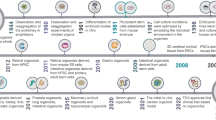Abstract
Epithelial-mesenchymal transition (EMT) is a cellular development program characterized by loss of cell adhesion and increased cell mobility. It is essential for numerous processes including metastasis. In this study we have generated “aggressive” MCF-7 breast cancer cells (MCF-7-EMT), which show significantly increased invasion in contrast to wild type MCF-7 (MCF-7 WT) cells. In addition, we have analyzed, whether these cell lines differ in their metastatic behavior in vivo and in expression of invasion and/or EMT-relevant genes. Invasive behavior of different human breast cancer cell lines was tested. “Aggressive” MCF-7 cells (MCF-7-EMT) were generated using coculture and mammosphere culture techniques. To analyze whether or not MCF-7-EMT cells in contrast to MCF-7 WT cells form metastases in vivo, we assessed metastases in a nude mouse model. mRNA expression profiles of MCF-7 WT cells and MCF-7-EMT cells were compared using the Affymetrix micro array technique. Expression of selected genes was validated using real-time PCR. In addition, protein expression of epithelial marker E-cadherin (CDH1) and mesenchymal markers N-cadherin (CDH2), Vimentin (VIM), and TWIST was compared. The breast cancer cell lines showed different invasive behavior from hardly any invasion to a stronger cell movement. Coculture with osteoblast-like MG63 cells led to significantly increased cell invasion rates. The highest increase was shown using MCF-7 WT cells. Generated MCF-7-EMT cells showed significantly increased invasion as compared to MCF-7 WT cells. In 8 of 10 mice bearing orthotopically growing MCF-7-EMT tumors, we could detect metastases in liver and lung. In mice bearing MCF-7 WT tumors (n = 10), no metastases were found. MCF-7 WT cells and MCF-7-EMT cells were different in expression of 325 genes. Forty-four of the most regulated 50 invasion and/or EMT-related genes were upregulated and 6 genes were downregulated in MCF-7-EMT cells. Protein expression of mesenchymal markers CDH2, VIM, and TWIST was clearly increased in MCF-7-EMT cells. Protein expression of epithelial marker CDH1 was clearly decreased. With the breast cancer cell lines, MCF-7-EMT and MCF-7 WT cells, we have an excellent model of cells for further studies of EMT and invasion in vitro and in vivo.





Similar content being viewed by others
References
Christiansen JJ, Rajasekaran AK (2006) Reassessing epithelial to mesenchymal transition as a prerequisite for carcinoma invasion and metastasis. Cancer Res 66(17):8319–8326
Kalluri R, Weinberg RA (2009) The basics of epithelial-mesenchymal transition. J Clin Invest 119(6):1420–1428
Guttilla IK, Phoenix KN, Hong X, Tirnauer JS, Claffey KP, White BA (2012) Prolonged mammosphere culture of MCF-7 cells induces an EMT and repression of the estrogen receptor by microRNAs. Breast Cancer Res Treat 132(1):75–85
Chomczynski P, Sacchi N (1987) Single-step method of RNA isolation by acid guanidinium thiocyanate-phenol-chloroform extraction. Anal Biochem 162(1):156–159
Curtis AE, Cooke JH, Baxter JE, Parkinson JR, Bataveljic A, Ghatei MA, Bloom SR, Murphy KG (2010) A kisspeptin-10 analog with greater in vivo bioactivity than kisspeptin-10. Am J Physiol Endocrinol Metab 298(2):E296–E303
Chua SL, See Too WC, Khoo BY, Few LL (2011) UBC and YWHAZ as suitable reference genes for accurate normalisation of gene expression using MCF7, HCT116 and HepG2 cell lines. Cytotechnology 63(6):645–654
Ferreira E, Cronje MJ (2012) Selection of suitable reference genes for quantitative real-time PCR in apoptosis-induced MCF-7 breast cancer cells. Mol Biotechnol 50(2):121–128
von Alten J, Fister S, Schulz H, Viereck V, Frosch KH, Emons G, Grundker C (2006) GnRH analogs reduce invasiveness of human breast cancer cells. Breast Cancer Res Treat 100:13–21
Olbrich T, Ziegler E, Turk G, Schubert A, Emons G, Grundker C (2010) Kisspeptin-10 inhibits bone-directed migration of GPR54-positive breast cancer cells: evidence for a dose-window effect. Gynecol Oncol 119(3):571–578
Schmidt E, Haase M, Ziegler E, Emons G, Grundker C (2014) Kisspeptin-10 inhibits stromal-derived factor 1-induced invasion of human endometrial cancer cells. Int J Gynecol Cancer 24(2):210–217
Yu Y, Xiao CH, Tan LD, Wang QS, Li XQ, Feng YM (2014) Cancer-associated fibroblasts induce epithelial-mesenchymal transition of breast cancer cells through paracrine TGF-beta signalling. Br J Cancer 110(3):724–732
Kudryavets YI, Bezdenezhnykh NO, Lykhova OO, Semesiuk NI, Vorontsova AL (2011) The role of interferon as a modifier of epithelial-mesenchymal transition in tumor cells. Exp Oncol 33(3):178–181
Ye Y, Xiao Y, Wang W, Yearsley K, Gao JX, Shetuni B, Barsky SH (2010) ERalpha signaling through slug regulates E-cadherin and EMT. Oncogene 29(10):1451–1462
Fujita N, Jaye DL, Kajita M, Geigerman C, Moreno CS, Wade PA (2003) MTA3, a Mi-2/NuRD complex subunit, regulates an invasive growth pathway in breast cancer. Cell 113(2):207–219
Eeckhoute J, Keeton EK, Lupien M, Krum SA, Carroll JS, Brown M (2007) Positive cross-regulatory loop ties GATA-3 to estrogen receptor alpha expression in breast cancer. Cancer Res 67(13):6477–6483
Dydensborg AB, Rose AA, Wilson BJ, Grote D, Paquet M, Giguere V, Siegel PM, Bouchard M (2009) GATA3 inhibits breast cancer growth and pulmonary breast cancer metastasis. Oncogene 28(29):2634–2642
Yan W, Cao QJ, Arenas RB, Bentley B, Shao R (2010) GATA3 inhibits breast cancer metastasis through the reversal of epithelial-mesenchymal transition. J Biol Chem 285(18):14042–14051
Song Y, Washington MK, Crawford HC (2010) Loss of FOXA1/2 is essential for the epithelial-to-mesenchymal transition in pancreatic cancer. Cancer Res 70(5):2115–2125
Acknowledgments
We thank Sonja Blume, Renate Diedrich, and Matthias Läsche for their excellent technical assistance.
Conflict of interests
The authors declare that they have no conflict of interest.
Author information
Authors and Affiliations
Corresponding author
Additional information
Elke Ziegler and Marie-Therese Hansen have contributed equally to this work.
Electronic supplementary material
Below is the link to the electronic supplementary material.
Rights and permissions
About this article
Cite this article
Ziegler, E., Hansen, MT., Haase, M. et al. Generation of MCF-7 cells with aggressive metastatic potential in vitro and in vivo. Breast Cancer Res Treat 148, 269–277 (2014). https://doi.org/10.1007/s10549-014-3159-4
Received:
Accepted:
Published:
Issue Date:
DOI: https://doi.org/10.1007/s10549-014-3159-4




